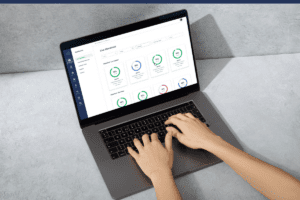Providing students with engaging content is the key to ensuring they can succeed in blended learning programs. Luckily, thanks to the abundance of information and content online, educators can think outside the box when creating engaging content for their students.
In this post, we’ll cover methods for creating highly engaging content that you can provide your students enrolled in blended learning.
Engagement is key
When developing content for your blended learning program, creating engaging content is of utmost importance. Content should not just be created to keep students’ attention, but to engage them and involve them in the material. Not only does it have a huge impact on comprehension, engagement is important to tracking student participation.
Incorporate assessments, group discussions, polls, etc. — activities that require student input and keep their focus high, instead of just assigning them the task of reading an online journal or watching a video.
If the content you assign students isn’t engaging, they talk themselves out of finishing it. For example, some students adopt the mindset of “I don’t feel like reading these 10 PDF pages – I’ll come back and read them when I feel ready to study.” That is not a recipe for effective learning.
Learning and comprehension is about generating and maintaining momentum through consistent reinforcement. Students who engage with learning material each day will solidify their learnings much more than if they’re simply asked to consume content. If the content is not engaging, students will lose focus and therefore lose momentum in their learning journey.
Do more than create digital versions of on-ground program content
Creating quality content for blended learning requires more than simply creating digital versions of the content normally distributed or assigned in class. Sending students a PDF of a chapter in a textbook is a mundane, unengaging way of teaching that will quickly lose students’ interest. Not to mention, it’s impossible to track if a student actually read the pages they were assigned.
That being said, content like that can still provide value in blended learning. It can be paired with an engagement tool like CourseKey Engage that prompts students to answer questions about the content or it can be made available to students as supplemental resources.
Take a multi-modal approach to asynchronous course components
Many institutions choose asynchronous (or self-paced) learning for the online portion of their blended learning programs, which is where the importance of providing highly engaging content comes in. Because students are learning alone, they can easily lose focus, therefore compromising their comprehension.
By incorporating different types of content mediums, like videos, simulations/games, articles and blogs, and more, and pairing them with an engagement tool, you can create an engaging digital learning experience during asynchronous course components. Below are a few examples of content you can provide students in an asynchronous environment.
- Videos of an instructor teaching part of the lesson or videos you find online that illustrate a certain topic.
- Assessments that ask questions about course material (i.e. an article students were assigned to read).
- Simulation/games are a form of interactive, informative content that plays on students’ competitive nature to keep them engaged.
- Longer form writing assignments that have to do with course material or a piece of content they consumed.
- Infographics to illustrate processes/cycles that are visually stimulating and easy to digest
While the internet provides many opportunities for informative content, pairing that content with an engagement tool like CourseKey Engage is the best way to ensure students are staying focused and learning from the material.
Synchronous content
Some blended learning programs incorporate synchronous online sessions, which are typically coursewide or group sessions with an instructor present. While these sessions are often reserved for discourse between instructors and students, guest speaker sessions, or group discussions, they can incorporate content as well.
For example, if an instructor asks students to watch a 15 minute video about a new skill, they can ask students to follow along by answering poll questions relating to the video. Involving students in the session this way helps improve student learning and keeps them focused.
Strategic content distribution
What good is amazing content if students can’t access it? The best way to successfully distribute content to students online is through a content repository such as an LMS or similar system. A content repository stores and organizes the course content online so that students can access it at any time, as long as they have connection to the internet.
Simply sharing content with students through email is not an effective way to distribute content. Emails get lost in inboxes and can lead to breakdowns in communication. Utilize a content repository so that students can consistently access course content in a single place.
Teach the student, not the content
Blended learning is a very effective teaching methodology when executed correctly. Because students spend a majority of their program learning online, it is critical to their success to provide them with engaging content on a daily basis. Not only does engaging content help students learn more effectively, it can provide institutions with insight into their level of participation and into how the student is performing. By incorporating some of the methods outlined above, you can create highly engaging content for your blended learning program.
Are you looking for a tool to provide engaging content to your students in blended learning? CourseKey Engage offers institutions with a content repository, easy to use assessments, and a method to track participation. Learn more by requesting a demo below.
Recent Articles

















